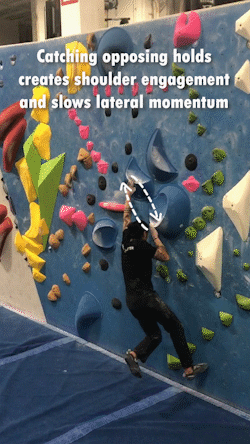Breakdown
Climber: Hans Ma 6’2”/-1
Wall Angle: Flat
Holds: Flathold Revival, Flathold Superstar
RIC: Risk 5, Complexity 3, Intensity 2
The objective for this boulder was to maximize risk while giving climbers an opportunity to learn the movements quickly. Risk ranks highest because of the coordination and commitment required to do the first move. The climber must trust their feet as well as perform a two-step movement to stop their momentum to control the movement. Additionally, the second half of the boulder requires slower, technical climbing that needs slow and methodical execution. Complexity is moderate because there are a few different techniques that need to be combined in succession to complete the boulder, but there is little beta variation. Intensity is low because physical strength can be negated through proper execution.
Influence/Aesthetic:
Initially, I wanted to set a variation of a palm-down move. During forerunning, it became clear that it would be easier to opt for the coordination catch. The goal was to combine multiple aspects of risk (bad feet, commitment, coordination) to increase difficulty. Placing this movement at the beginning of the boulder allows climbers to repeatedly try the move and dial in their approach. This makes learning muscle memory a bit more forgiving because of how repeatable the move is. Aesthetically, the boulder revolves around the central cluster of three holds. The start foot and finish hand also complement each other in orientation. This climb serves to give a visual simplicity paired with complex movement.
Hold Selection:
Fiberglass slopers tend to be a go-to pick when setting coordination movements. They provide a large area to grab which improves the margin for error but can be difficult to control if body positioning isn’t approached correctly. The target sloper is positioned away from the climber to promote lateral movement, with the catch hold being a large target to stop the momentum. Using fiberglass slopers as feet offers a similar advantage where the climber can have a wide surface area to step on. However, this area is not so positive that they can stand with no hands. This encourages dynamic movement.
Time Over Feet
Hans begins the boulder in a position where his hips are placed leftward and he has to transition his weight far to the right.
He pulls inward with his right hand to begin shifting his weight towards his right foot.
Standing up straight maximizes the amount of time he is able to keep his right foot planted before needing to jump toward the next two holds.
Stop n’ Go
Hans first gains the left-hand sloper but needs to stop his momentum.
Moving his hand downward lets him gain the next right-facing sloper, this opposition allows his shoulders to engage and stop his upper body from falling out from the wall.
Combining this opposition with smearing on the wall brings Hans’ momentum to a stop.
Taking the Top
Hans gains a high foot and begins locking off on the slopers.
The position is constricted, which prevents him from reaching a fully extended position by pulling alone.
He flips his left hand to begin pushing, this takes the weight off of his leg and allows him to stand up straight.
This squares his hips and allows him to bring his left foot up to gain the finish.
Final Thoughts
Unfortunately, this boulder ended up being breakable. Depending on the size of the climber, it is possible to gain a far-right foot on the cluster of holds you jump to. This makes it so you can do the move static, and not dynamic. We tried to fix this by making the left-hand start hold smaller and harder to match, but climbers can still piano match on the crimp that is there now. Albeit the dynamic movement is easier, it can be daunting for climbers to attempt a move with so many aspects. As a routesetter it is frustrating to see a boulder get broken. However, it often offers valuable feedback to set a more intuitive experience in the future.



